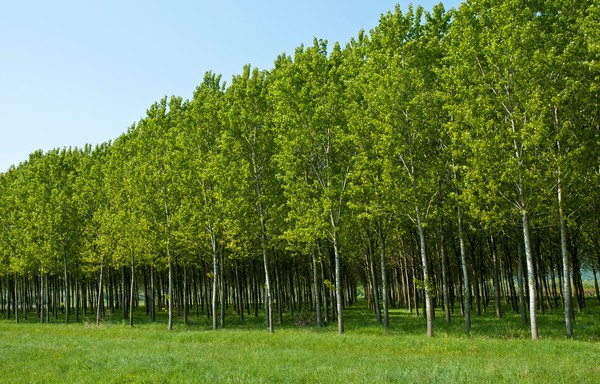
Poplar Harvesting: solutions for every production purpose
Poplar has always been exploited for paper and lumber production. However, for several years it has become the species of choice in so-called Short Rotation Forestry, short rotation coppice plantations
The genus Populus L., widely distributed in temperate climates, is a set of fast-growing tree species. It is a pioneer plant that is capable of surviving in environments that are borderline hostile. It thrives well in humid soils, such as riverbanks and uncultivated land: In fact, it is often recognizable along river and canal beds. Thanks to its adaptability and successful integration with other crops, it is often planted in association with agricultural crops to create ecological corridors and provide shade for animal rest areas. Poplar trees have an erect habit, reaching heights of 15-20 meters and trunk circumference exceeding 2 meters. Due to its rapid growth and versatile uses of timber, poplar cultivation has become widespread, with planting sites in square or rectangular patterns and typical spacing between trees of about 5-7 meters.
Uses
Poplar cultivation is probably the most widespread form of woody biomass cultivation in many countries worldwide. Its ecological and environmental characteristics, combined with its rapid growth, enable the storage of significant amounts of CO2 in a short period of time. Productive uses include opera lumber, firewood (logs, wood chips, pellets), poles and as well as, of course, it is the primary raw material for the paper industry. Poplar wood fiber is lightweight and suitable for producing boards of various sizes or, alternatively, plywood panels, including multi-layer ones. Conversely, as for its use for energy purposes through combustion, poplar can be packaged in logs, wood chips or pellets. Pellets, compressed sawdust made under high pressure, have gained significant success in the energy and heating sector in recent years. Logs can vary in length, depending on the intended use, and are properly prepared through log splitters. Chips, dried and then combusted in thermal power plants, can also be obtained as a byproduct of timber for construction, poles, as well as branches and other wood waste. To meet the high market demand, approximately 50% of poplar wood used in Italy comes from France, Belgium, and Hungary.
Short Rotation Forestry
Specifically regarding chips, shorter-duration plantations have become increasingly prevalent, especially in Northern Italy, aiming to maximize productivity per unit area. This approach is known as Short Rotation Forestry (SFR), which involves poplar cultivation with short-rotation coppice management, with maximum cutting cycles of 5 years, which can also be profitably alternated with the usual agricultural crops. The following are the most frequently practiced rotations.
The Very Short Rotation Coppice with Annual Harvesting, which involves high planting density (approximately 10,000 plants/ha) with a double-row pattern spaced at around 0.7-0.8 meters and an inter-row spacing of 1.8-2 meters. Coppicing is carried out when the trunk diameter reaches a maximum of 6-8 cm, and the harvested material is exclusively used for producing wood chips for energy purposes through combustion.
Short-Rotation Coppice: typically involves a biennial cutting cycle with a planting density of approximately 6-7,000 plants/ha. At harvest, plant diameters average 10 cm, therefore with a size that is easy to harvest and process directly. The wood obtained from this rotation is also used for wood chip production.
Medium Rotation Coppice: This rotation has cutting intervals of 5 to a maximum of 8 years. The wood obtained from this rotation has a higher value, typically being the so-called "paper mill roundwood." Due to the relatively long time the trees remain in the field, replanting with new clones is often preferred over regenerating through stump sprouting.
Harvesting methods
In poplar production, various harvesting methods are employed with different levels of mechanization. The typical harvesting site involves the felling of logs immediately depeeled into sections of about 2 m in length, but whole trees are sometimes harvested, possibly after de-limbing. Traditional harvesting features limited mechanization: the chainsaw cuts down and then sets up the plant by de-limbing and depeeling.
Finally, agricultural tractors adapted for forestry are often used to load and transport timber. Mechanized harvesting significantly reduces the harvesting time. The highest productivity is achieved with machines specifically designed for forestry activities, such as harvesters and skidders. However, due to their high cost, such vehicles are not widely used in Italy. In particular, harvesters are equipped with a hydraulically operated cutting head consisting of an articulated hydraulic arm that ends with a gripper equipped with claws to hold the tree trunk during and after cutting. The cutting can be done using a rotating blade, a shear, or a hinged bar with a cutting chain. The cutting head can be complemented with modules for de-limbing and sectioning, which perform combined processing and are completed with a crane arm with an end gripper for handling and loading the log sections. De-limbing is carried out with 4 or more knives installed on the grapple, thanks to the sliding of the log along its entire length by a pair of gripping and dragging wheels or tracks. The cutting into the intended sizes is subsequently carried out by the same cutting organ used for felling. Given the typical arrangement of the trees in poplar plantations, no grubbing is necessary. The de-limbed material is loaded for transport directly onto a truck or tractor-drawn trailer. If the transportation of whole plants (whether de-limbed or not) is chosen, a forwarder can be used, which is an articulated vehicle with a loading platform equipped with sturdy vertical bars.
Mechanization in the SFR
Short-shift poplar harvesting is based on machines that, depending on the type, cut down, harvest, process and convey the product, then load it onto suitable trailers. The entire work routine can be carried out in one or two stages, depending on whether a single unitized yard machine is available (a suitably equipped mowing-chipping-loading machine), which is capable simultaneously of felling, chopping and loading the product, or if action is taken first for felling only (mowing-and-rowing machine) and then for chopping and loading the material (with a chopping-loading machine). In either case, the cutting header consists of stem intercepting and conveying devices (augers or bulkheads) that direct the stems toward two strong counter-rotating toothed discs, which cut the stems a few centimeters above the ground. Plants can be laid in windrows, in the case of two-stage harvesting, or conveyed to the feeding unit, which consists of a series of toothed rollers that regulate the product flow to the chopping drum. The latter is equipped with a series of radial knives that perform the chopping against a fixed counter-knife. Thanks to the presence of special paddles, the very motion of the rotor creates a powerful flow of air that orients and directs the wood chips into a curved, adjustable duct, known as a "gooseneck," for discharging into the body of a tractor-drawn trailer, which moves continuously alongside the harvesting machine.
Poplar varieties
Poplar is particularly widespread in Italy and even in Europe. Several poplar species grow in Italy: the most widespread is the black poplar (Populus nigra). This variety is characterized by dark bark, an upright habit, and a long, narrow crown and is particularly widespread in the North. Another popular species is the white poplar (Populus alba), on average, is slightly more long-lived and hardier than Populus nigra. It is often planted in parks. On the other hand, trembling aspen (Populus tremula) is widely distributed in mountainous areas due to its characteristics as a pioneer plant that adapts well to unstable and landslide-prone slopes.
Agricultural tractors in the forest
These vehicles were originally designed for agricultural use, typically equipped with four-wheel drive integrated with additional elements and accessories for profitable and safe forestry use. The driver's seat must be fitted with a protective structure in case of overturning (ROPS), and often additional protections are added to prevent objects from falling on the operator (FOPS, Falling Object Protective Structure) or from external elements entering the cabin (OPS, Operator Protective Structure). Furthermore, strong shields of shaped sheet metal are applied ventrally to protect the tractor body from dangerous impacts with outcropping boulders, ground roughness, and stumps. The severe characteristics of the topsoil then dictate the fitting of reinforced carcass tires, with guards on the inflation valves to prevent their damage or even shearing due to crawling or impact with protruding rocks. In order to improve traction, especially on steep slopes and wet ground, chains can be applied to the tires.








